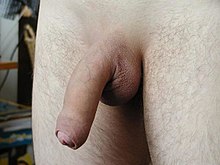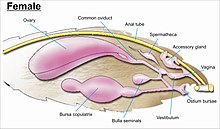Sex organ

Asex organ,also known as areproductive organ,is a part of an organism that is involved insexual reproduction.Sex organs constitute the primarysex characteristicsof an organism. Sex organs are responsible for producing and transportinggametes,as well as facilitatingfertilizationand supporting the development andbirthof offspring. Sex organs are found in many species of animals and plants, with their features varying depending on the species.
Sex organs are typically differentiated intomaleandfemaletypes.
In animals (including humans), the male sex organs include thetesticles,epididymides,andpenis;the female sex organs include theclitoris,ovaries,oviducts,andvagina.The testicle in the male and the ovary in the female are called theprimary sex organs.[1]All other sex-related organs are known assecondary sex organs.The outer organs are known as thegenitalsorexternal genitalia,visible at birth in both sexes,[1][pages needed]while the inner organs are referred to asinternal genitalia,which in both sexes, are always hidden.[2]
In plants, male reproductive structures includestamensin flowering plants, which producepollen.[3]Female reproductive structures, such aspistilsin flowering plants, produceovulesand receive pollen for fertilization.[4]Mosses,ferns,and some similar plants havegametangiafor reproductive organs, which are part of thegametophyte.[5]Theflowersofflowering plantsproduce pollen andegg cells,but the sex organs themselves are inside the gametophytes within the pollen and the ovule.[6]Coniferous plantslikewise produce their sexually reproductive structures within the gametophytes contained within theconesand pollen. The cones and pollen are not themselves sexual organs.
Together, the sex organs constitute an organism'sreproductive system.[7]
Terminology[edit]
This sectionrelies largely or entirely upon asingle source.(August 2021) |
Theprimary sex organsare thegonads,a pair of internal sex organs, which diverge intotesticlesfollowing male development or intoovariesfollowing female development.[citation needed]As primary sex organs, gonads generate reproductivegametescontaining inheritableDNA.They also produce most of the primary hormones that affect sexual development, and regulate other sexual organs and sexually differentiated behaviors.
Secondary sex organsare the rest of the reproductive system, whether internal or external. TheLatintermgenitalia,sometimes anglicized asgenitals,is used to describe the externally visible sex organs.
In generalzoology,given the great variety in organs, physiologies, and behaviors involved incopulation,male genitalia are more strictly defined as "all male structures that are inserted in the female or that hold her near hergonoporeduring sperm transfer "; female genitalia are defined as" those parts of the female reproductive tract that make direct contact with male genitalia or male products (sperm,spermatophores) during or immediately after copulation ".[8][page needed]
Evolution[edit]
It is hard to find a common origin forgonads.However, gonads most likely evolved independently several times.[9]At first,testesandovariesevolved due tonatural selection.[10]
A consensus has emerged thatsexual selectionrepresents a primary factor for genital evolution.[11]Male genitalia show traits ofdivergent evolutionthat are driven by sexual selection.[12]
Animals[edit]
Mammals[edit]
The visible portion ofeutherianmammaliangenitals for males consists of thepenisandscrotum;for females, it consists of thevulva.
Inplacental mammals,females have two genital orifices, thevaginalandurethral openings,while males have only one for the urethra.[13]Male and female genitals have many nerve endings, resulting in pleasurable and highly sensitive touch.[14]In most human societies, particularly inconservativeones, exposure of the genitals is considered apublic indecency.[15]
In humans, sex organs/genitalia include:
| Male | Female |
|---|---|
|
External Internal  |
External Internal  |
Development[edit]
This sectionneeds additional citations forverification.(August 2021) |
In typicalprenatal development,sex organs originate from a commonprimordiumduring earlygestationanddifferentiateinto male or femalesexes.TheSRYgene,usually located on theY chromosomeand encoding thetestis determining factor,determines the direction of the differentiation. The absence of it allows the gonads to continue to develop into ovaries.
The development of the internal and external reproductive organs is determined by hormones produced by certain fetal gonads (ovaries or testicles) and the cells' response to them. The initial appearance of thefetalgenitalia looks female-like: a pair ofurogenital foldswith a small protuberance in the middle, and theurethrabehind the protuberance. If the fetus has testes and the testes produce testosterone, and if the cells of the genitals respond to the testosterone, the outer urogenital folds swell and fuse in the midline to produce the scrotum; the protuberance grows larger and straighter to form the penis; the inner urogenital swellings grow, wrap around the penis, and fuse in the midline to form thepenile raphe.[16][17]Each sex organ in one sex has ahomologouscounterpart.
The process of sexual differentiation includes the development ofsecondary sexual characteristics,such as patterns of pubic and facial hair and female breasts that emerge at puberty.
Because of the strongsexual selectionaffecting the structure and function of genitalia, they form an organ system that evolves rapidly.[18][19][20]A great variety of genital form and function may therefore be found among animals.
In many other animals, a single posterior orifice (thecloaca) serves as the only opening for the reproductive, digestive, and urinary tracts (if present) in both sexes. Allamphibians,birds,reptiles,[21]some fish, and a few mammals (monotremes,tenrecs,golden moles,andmarsupial moles) have this orifice, from which they excrete both urine and feces in addition to serving reproductive functions.[22]Excretory systems with analogous purpose in certain invertebrates are also sometimes referred to as cloacae.
Sexingfish is determined by the shape of a fleshy tube behind the anus known asgenital papilla.
Insects[edit]

The organs concerned withinsectmating and the deposition of eggs are known collectively as the external genitalia, although they may be largely internal; their components are very diverse in form.
Slugs and snails[edit]
The reproductive system of gastropods (slugs and snails) varies greatly from one group to another.
Planaria[edit]
Planariaare flat worms widely used in biological research. There are sexual and asexual planaria. Sexual planaria are hermaphrodites, possessing both testicles and ovaries. Each planarian transports its excretion to the other planarian, giving and receiving sperm.
Plants[edit]
In most plant species, an individual has both male and female sex organs (ahermaphrodite).[23]
Thelife cycleofland plantsinvolvesalternation of generationsbetween asporophyteand ahaploidgametophyte.[24]Thegametophyteproduces sperm or egg cells bymitosis.The sporophyte produces spores bymeiosis,which in turn develop into gametophytes. Any sex organs that are produced by the plant will develop on the gametophyte. Theseed plants,which includeconifersandflowering plants,have small gametophytes that develop inside the pollen grains (male) and theovule(female).
Flowers[edit]
In flowering plants, theflowerscontain the sex organs.[25]
Sexual reproduction inflowering plantsinvolves the union of the male and female germ cells, sperm and egg cells respectively. Pollen is produced instamensand is carried to thepistil,which has theovaryat its base wherefertilizationcan take place. Within each pollen grain is a male gametophyte, which consists of only three cells. In most flowering plants, the female gametophyte within the ovule consists of only seven cells. Thus there are no sex organs as such.
Fungi[edit]
The sex organs infungiare known asgametangia.In some fungi, the sex organs are indistinguishable from each other but, in other cases, male and female sex organs are clearly different.[26]
Similar gametangia that are similar are known as isogametangia. While male and female gametangia are known as heterogametangia, which occurs in the majority of fungi.[27]
See also[edit]
References[edit]
- ^abClark, Robert K. (2005).Anatomy and Physiology: Understanding the Human Body.Jones & Bartlett Learning. p. 25.ISBN9780763748166.
- ^Deol, Pooja Soni (2023).ANATOMY PHYSIOLOGY OF FEMALE REPRODUCTIVE SYSTEM.Blue Rose Publishers. p. 14.
- ^"Parts of a Flower".American Museum of Natural History.Archivedfrom the original on 19 March 2023.Retrieved19 March2023.
- ^Chisholm, Hugh,ed. (1911)..Encyclopædia Britannica.Vol. 22 (11th ed.). Cambridge University Press. pp. 2–5.
- ^"Mosses and Ferns".Biology.clc.uc.edu. 16 March 2001. Archived fromthe originalon 28 July 2012.Retrieved1 August2012.
- ^"Flowering Plant Reproduction".Emc.maricopa.edu. 18 May 2010. Archived fromthe originalon 8 October 2012.Retrieved1 August2012.
- ^Chisholm, Hugh,ed. (1911)..Encyclopædia Britannica.Vol. 23 (11th ed.). Cambridge University Press.
- ^Eberhard, W.G., 1985. Sexual Selection and Animal Genitalia. Harvard University Press
- ^Schmidt-Rhaesa, Andreas (30 August 2007).The Evolution of Organ Systems.Oxford University Press. p. 252.ISBN978-0-19-856668-7.
- ^switze, International Conference on Comparative Physiology 1992 Crans; Bassau, Short & (4 August 1994).The Differences Between the Sexes.Cambridge University Press. p. 54.ISBN978-0-521-44878-9.
{{cite book}}:CS1 maint: numeric names: authors list (link) - ^Langerhans, R. Brian; Anderson, Christopher M.; Heinen-Kay, Justa L. (6 September 2016)."Causes and Consequences of Genital Evolution".Integrative and Comparative Biology.56(4): 741–751.doi:10.1093/icb/icw101.ISSN1540-7063.PMID27600556.
- ^Simmons, Leigh W. (2014)."Sexual selection and genital evolution".Austral Entomology.53(1): 1–17.doi:10.1111/aen.12053.ISSN2052-1758.S2CID53690631.
- ^Marvalee H. Wake(1992).Hyman's Comparative Vertebrate Anatomy.University of Chicago Press. p. 583.ISBN978-0-226-87013-7.
- ^Brigitta Olsen (15 November 2009).Daphne's Dance: True Tales in the Evolution of Woman's Sexual Awareness.Brigitta Olsen. p. 9.ISBN978-0-9842117-0-8.
- ^Anita Allen (November 2011).Unpopular Privacy: What Must We Hide?.Oxford University Press, US. p. 219.ISBN978-0-19-514137-5.
- ^Hodges, Frederick Mansfield S.; Denniston, George C.; Milos, Marilyn Fayre (2007).Male and Female Circumcision: Medical, Legal, and Ethical Considerations in Pediatric Practice.Springer US. p. 10.ISBN978-0-58539-937-9.Retrieved24 November2023.
- ^Martin, Richard J.; Fanaroff, Avory A.; Walsh, Michele C. (2014).Fanaroff and Martin's Neonatal-Perinatal Medicine E-Book: Diseases of the Fetus and Infant.Elsevier Health Sciences. p. 1522.ISBN978-0-32329-537-6.Retrieved24 November2023.
- ^Hosken, David J., and Paula Stockley. "Sexual selection and genital evolution."Archived12 October 2017 at theWayback MachineTrends in Ecology & Evolution 19.2 (2004): 87-93.
- ^Arnqvist, Göran. "Comparative evidence for the evolution of genitalia by sexual selection."Archived27 January 2012 at theWayback MachineNature 393.6687 (1998): 784.
- ^Schilthuizen, M. 2014.Nature's Nether Regions: What the Sex Lives of Bugs, Birds, and Beasts Tell Us About Evolution, Biodiversity, and OurselvesArchived14 June 2023 at theWayback Machine.Penguin USA
- ^"Male reproductive behaviour of Naja oxiana (Eichwald, 1831) in captivity, with a case of unilateral hemipenile prolapse".2018.
- ^"Page:The Works of William Harvey (part 1 of 2).djvu/283 - Wikisource, the free online library".en.wikisource.org.Archivedfrom the original on 25 March 2023.Retrieved25 March2023.
- ^Purves, William K.; Sadava, David E.; Orians, Gordon H.; Heller, H. Craig (2001).Life: The Science of Biology.Macmillan. p. 176.ISBN978-0-7167-3873-2.
- ^Pal, Nishant (6 December 2021).Plant Biology.Independently Published.ISBN979-8-7799-0473-5.Archivedfrom the original on 10 April 2023.Retrieved25 March2023.
- ^Purves, William K.; Sadava, David E.; Orians, Gordon H.; Heller, H. Craig (2001).Life: The Science of Biology.Macmillan. p. 665.ISBN978-0-7167-3873-2.
- ^Heritage, J.; Evans, E. G. V.; Killington, R. A. (26 January 1996).Introductory Microbiology.Cambridge University Press. p. 19.ISBN978-0-521-44977-9.
- ^Manoharachary, C.; Tilak, K. V. B. R.; Mallaiah, K. V.; Kunwar, I. K. (1 May 2016).Mycology and Microbiology (A Textbook for UG and PG Courses).Scientific Publishers. p. 328.ISBN978-93-86102-13-3.
Further reading[edit]
- Leonard, Janet L.; Córdoba-Aguilar, Alex (2010).The Evolution of Primary Sexual Characters in Animals.Oxford: Oxford University Press.ISBN978-0199717033.
